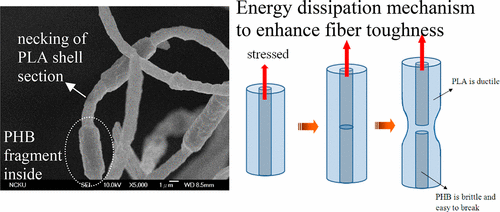当前位置:
X-MOL 学术
›
Biomacromolecules
›
论文详情
Our official English website, www.x-mol.net, welcomes your
feedback! (Note: you will need to create a separate account there.)
Core–Shell Fibers Electrospun from Phase-Separated Blend Solutions: Fiber Formation Mechanism and Unique Energy Dissipation for Synergistic Fiber Toughness
Biomacromolecules ( IF 5.5 ) Pub Date : 2017-08-30 00:00:00 , DOI: 10.1021/acs.biomac.7b00863 Chi Wang,Ting-Ting Hsiue
Biomacromolecules ( IF 5.5 ) Pub Date : 2017-08-30 00:00:00 , DOI: 10.1021/acs.biomac.7b00863 Chi Wang,Ting-Ting Hsiue

|
Through single-tube electrospinning, the biodegradable core–shell fibers of poly(3-hydroxybutyrate) (PHB) and poly(d,l-lactic acid) (PDLLA) were obtained from blend solutions with different compositions at a total polymer concentration of 7 wt %. Regardless whether PHB is the major or minor component (PHB/PDLLA = 90/10, 75/25, 50/50, and 25/75 wt. ratio), these phase-separated solutions all yielded core–shell fibers with PHB as core and PDLLA as shell. A new scenario of core–shell fiber formation was proposed on the basis of the relative magnitude of the intrinsic relaxation rate of fluids and external extension rate during electrospinning. The effects of blend compositions on the morphologies of the Taylor cone, whipping jet, and as-spun fibers were investigated. The diameters of core–shell fibers can be tailored by simply varying the PHB/PDLLA ratios. Two scaling laws describing the apparent viscosity (ηo) dependence of the outer fiber diameter (dfo) and core fiber diameter (dfc) were derived. That is, dfo ∼ ηo0.38 and dfc ∼ ηo0.86. The microstructures of the as-spun fibers were determined by differential scanning calorimetry, Fourier transform infrared spectroscopy, and synchrotron wide-angle and small-angle X-ray scatterings. Results showed that the PDLLA component was in the amorphous state, and the crystallizability of PHB component remained unchanged, except the amorphous 10/90 fibers electrospun from a miscible solution state. The synergistic mechanical properties of the core–shell fibers were obtained, along with the ductile PDLLA shell enclosing the brittle PHB core. The enhanced toughness was attributed to the fragmentation of the brittle PHB core and necking fracture of the ductile PDLLA shell, which served as an effective route for energy dissipation. Compared with the neat PHB fiber, the 90/10 and 75/25 core–shell fibers possessed larger elastic moduli, which was attributed to the high PHB crystal orientation in their core sections despite the reduced PHB crystallinity. By contrast, the crystal c-axis of PHB in the 25/75 core–shell fibers was preferentially perpendicular to the fiber axis, suggesting the significant stretching of developing PHB crystals during electrospinning.
中文翻译:

相分离共混解决方案中电纺的核壳纤维:纤维形成机理和独特的能量耗散,可增强纤维的韧性
通过单管静电纺丝,聚(3-羟基丁酸酯)(PHB)和聚(d,lα-乳酸)(PDLLA)是由具有不同组成的共混溶液获得的,总聚合物浓度为7 wt%。不管PHB是主要成分还是次要成分(PHB / PDLLA = 90 / 10、75 / 25、50 / 50和25/75重量比),这些相分离的溶液都产生了以PHB为芯的核-壳纤维和PDLLA作为外壳。在静电纺丝过程中,根据流体的固有弛豫率和外部延伸率的相对大小,提出了一种形成核-壳纤维的新方案。研究了共混物组成对泰勒锥,搅打射流和初纺纤维形态的影响。可以通过简单地改变PHB / PDLLA比率来定制核-壳纤维的直径。两个描述的表观粘度缩放法(η Ò)得出了外部纤维直径(d fo)和芯纤维直径(d fc)的依赖性。即,d FO〜η ö 0.38和d FC〜η ö 0.86。通过差示扫描量热法,傅立叶变换红外光谱法以及同步加速器广角和小角X射线散射测定初生纤维的微观结构。结果表明,PDLLA组分处于非晶态,PHB组分的结晶性保持不变,除了非晶态10/90纤维是从互溶溶液态纺丝的。获得了核-壳纤维的协同机械性能,以及包围脆性PHB核的韧性PDLLA壳。韧性的提高归因于脆性PHB芯的破碎和韧性PDLLA壳的颈缩断裂,这是有效的能量消散途径。与纯PHB纤维相比,90/10和75/25核-壳纤维具有更大的弹性模量,尽管PHB结晶度降低,但归因于其核心部分的PHB晶体取向高。相比之下,水晶25/75核-壳纤维中PHB的c轴优先垂直于纤维轴,表明在电纺丝过程中正在发育的PHB晶体显着拉伸。
更新日期:2017-08-30
中文翻译:

相分离共混解决方案中电纺的核壳纤维:纤维形成机理和独特的能量耗散,可增强纤维的韧性
通过单管静电纺丝,聚(3-羟基丁酸酯)(PHB)和聚(d,lα-乳酸)(PDLLA)是由具有不同组成的共混溶液获得的,总聚合物浓度为7 wt%。不管PHB是主要成分还是次要成分(PHB / PDLLA = 90 / 10、75 / 25、50 / 50和25/75重量比),这些相分离的溶液都产生了以PHB为芯的核-壳纤维和PDLLA作为外壳。在静电纺丝过程中,根据流体的固有弛豫率和外部延伸率的相对大小,提出了一种形成核-壳纤维的新方案。研究了共混物组成对泰勒锥,搅打射流和初纺纤维形态的影响。可以通过简单地改变PHB / PDLLA比率来定制核-壳纤维的直径。两个描述的表观粘度缩放法(η Ò)得出了外部纤维直径(d fo)和芯纤维直径(d fc)的依赖性。即,d FO〜η ö 0.38和d FC〜η ö 0.86。通过差示扫描量热法,傅立叶变换红外光谱法以及同步加速器广角和小角X射线散射测定初生纤维的微观结构。结果表明,PDLLA组分处于非晶态,PHB组分的结晶性保持不变,除了非晶态10/90纤维是从互溶溶液态纺丝的。获得了核-壳纤维的协同机械性能,以及包围脆性PHB核的韧性PDLLA壳。韧性的提高归因于脆性PHB芯的破碎和韧性PDLLA壳的颈缩断裂,这是有效的能量消散途径。与纯PHB纤维相比,90/10和75/25核-壳纤维具有更大的弹性模量,尽管PHB结晶度降低,但归因于其核心部分的PHB晶体取向高。相比之下,水晶25/75核-壳纤维中PHB的c轴优先垂直于纤维轴,表明在电纺丝过程中正在发育的PHB晶体显着拉伸。











































 京公网安备 11010802027423号
京公网安备 11010802027423号